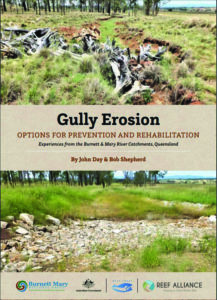Written by John Day and Bob Shepherd
Gully erosion is a major environmental challenge for landholders across Queensland. During an intense rainfall event most landscapes will generate surface runoff. This tends to concentrate in narrow pathways between grass tussocks, animal trails and vehicle tracks. As the velocity increases, the force cuts deeper into the soil. Sound familiar? Well, you’re not alone.
Gullies are considered the worst stage of soil erosion due to the permanent damage they cause. They are also a significant contributor to sediment flowing into waterways, Moreton Bay and the Great Barrier Reef. Rehabilitating gully erosion has long been a source of confusion and contention for land managers due to the complex nature of the problem.
Thankfully, this new publication gives us clear and succinct information about remediation and prevention practices. As part of an Australian Government grant aimed at the protection of the Great Barrier Reef, the Burnett Mary Regional Group (BMRG) have developed this best practice manual to preventing and remedying gully erosion. The recommendations in it are applicable and transferable to the SEQ region.
Now this may come as a shock to you, but I am not a farmer. I have never had to deal with the despair and hopelessness when a flood takes out a massive chunk of my paddock, taking with it fencing, access tracks and watering troughs. But I do visit properties suffering from gully erosion and have the role of advising landholders on remediation options, so from that perspective, here are my musings on this publication.
Every property visit I do where the landholder has gully erosion issues or wants to establish off-stream watering and/or fencing off creek and remnant vegetation, I will be taking a copy of this manual to help inform these projects.
Despite my academic background and 10-year career, I still learnt a lot from reading this manual and will continue to use it as a reference for years to come. I will also be incorporating the information from this manual into my Voluntary Conservation Agreement (VCA) Management Plans and Land for Wildlife property reports where appropriate.
I really value that the manual provides clear, concise and easy to use matrices and formulas to calculate spacing, widths and depths of the various improvement options, taking a lot of the guesswork out of these types of projects. The information is justified with cost-saving and livestock health reasoning, not just environmental and water quality motivations, making it more likely to be adopted by more landholders (not just conservationists).
There are many myths around gully erosion causes and treatment options and I liked that the manual debunks a lot of these. I think the section on prevention is an absolute must-read for all rural landholders, especially those who have recently purchased a rural property.
From reading this manual my mind is spinning with opportunities, including the development of targeted fact sheets, workshops to disseminate practical information and using social media to spread erosion control tips and generate broader discussion.
Review by Danielle Outram
Published by Burnett Mary Regional Group, 2019
Download for free from BMRG at www.bmrg.org.au
To request a hard-copy, contact BMRG on (07) 4181 2999 or admin@bmrg.org.au


Where can I get a copy of this book. We have had recent erosion in our gully/ council waterway easement and would like to stop in. A new development just up-gully from us is also dumping large amounts of sediment in our place changing the water path. What can we do??
Hi Warren. You can download this book for free from https://bmrg.org.au/resources/bmrg-publications/
What are our rights in Queensland to constructing erosion mitigation on our properties, especially when council refuses to help you repair what their storm drain has damaged. I have 15 m high eroded gully walls close to where children play and there seems to be no other option but to install pipe and fill it in until it becomes a non fatal height!? I should add that this gully erodes into a well known main river. So far in excess of 15000m3 has washed in due to the local councils inaction.